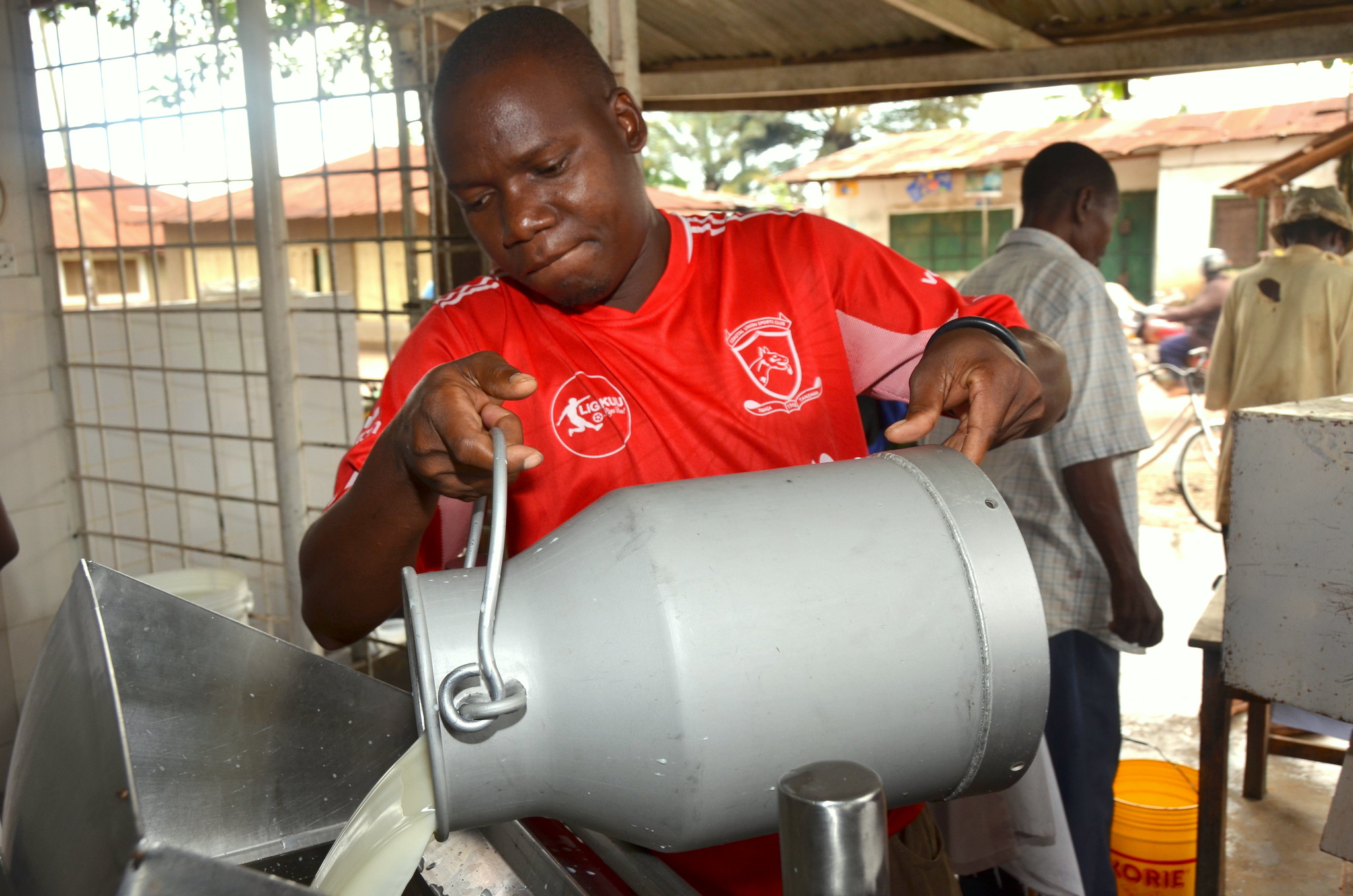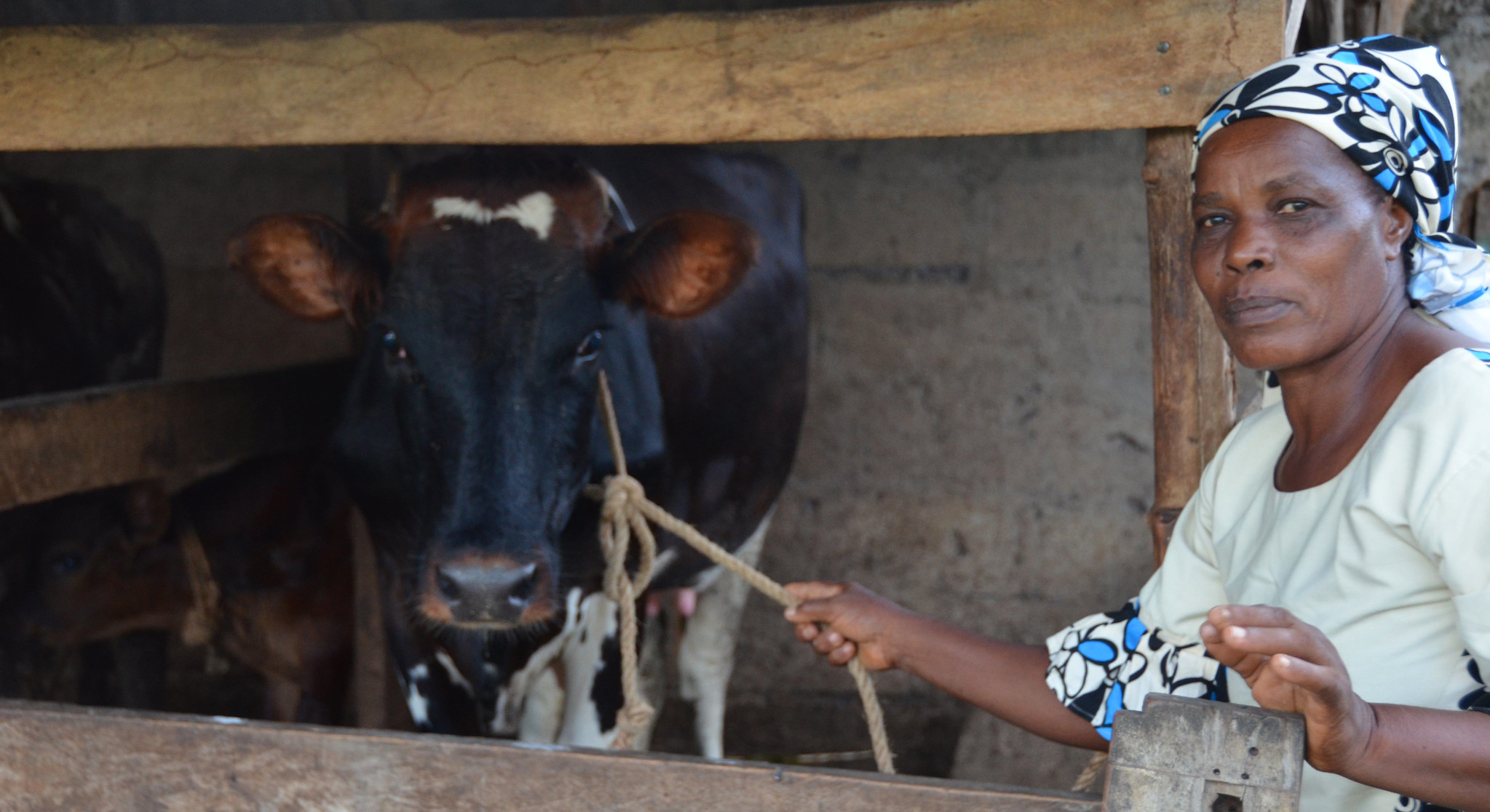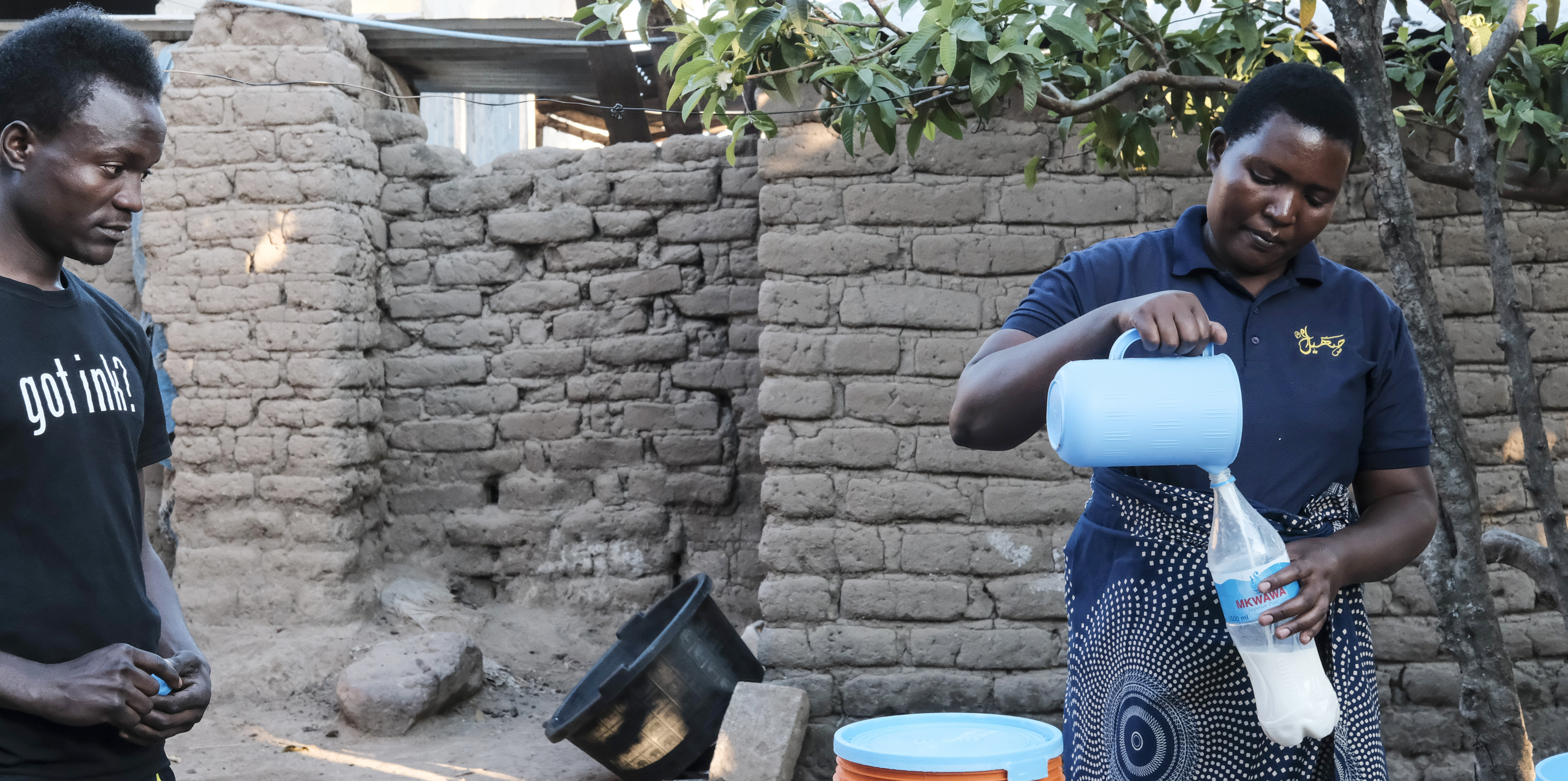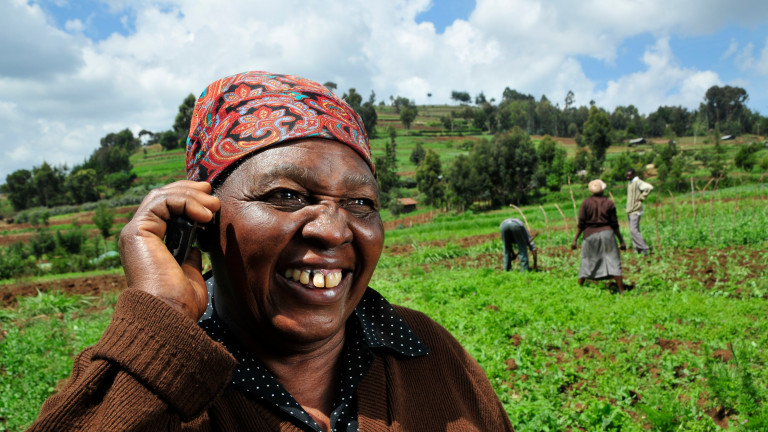
Combining powerful genetic analysis, farmer training, digital monitoring and SMS technology, the African Dairy Genetic Gains research program is helping thousands of dairy farmers across Tanzania to rear adaptive, productive and resilient dairy cattle.
“We have demonstrated that milk production in Tanzania can significantly increase in the coming decades. Our initial efforts have already helped farmers increase their cows’ daily milk production by up to 60 percent,” says Okeyo Mwai, principal scientist at the International Livestock Research Institute and director of the African Dairy Genetic Gains program (ADGG).
The program has also provided strong evidence that, in Tanzania’s smallholder dairy farms, the best performing cattle are crossbreeds. This has led to crossbred bulls and semen being included in the national artificial insemination (AI) program for the first time.
“Previously, we would provide only purebred exotic semen to dairy farmers as we believed it was superior. The ADGG has given us the data we need to confidently offer dairy farmers the option of crossbred bull semen through our AI program,” says Hassan Ally Mruttu, National Coordinator for Management of Animal Genetic Resources at Tanzania’s Ministry of Livestock and Fisheries.
As East Africa’s population and economy has grown over the past decades, so too has the demand for dairy products. Unfortunately, the region’s dairy farmers have struggled to meet that demand.

“Most farmers were previously keeping indigenous cattle breeds that don’t produce much milk. To increase milk production, exotic cattle breeds with higher milk producing potential have been continuously promoted in past 50 or so years,” Okeyo says.
“However, these cows are often not best suited to smallholder environments and end up being not very profitable for farmers to keep.”
One way that governments have been promoting the use of exotic breeds has been by progressively ‘upgrading’ the local indigenous cattle through crossbreeding. This is when indigenous cows are bred to exotic commercial dairy bulls either through natural service or artificial insemination (AI) service.
“The crossbreds have the best of their parent’s attributes – that is they exhibit higher milk production potential from their exotic parent, as well as the resilience from their indigenous parent. By using crossbreeds, the farmers gets a nice balance of adaptation and production capability,” Okeyo says.
Challenging long held assumptions
Optimising this balance of adaptation and production potential relies on collecting quality performance and pedigree data, analyzing and interpreting it correctly and sharing the results with farmers. The results can then be used to develop clear breeding objectives and goals.
The way this is usually done is through a country’s agricultural extension system, which employs extension workers to manually collect data, provide farmer advisory services, and provide feedback on the collected data and results obtained from analyses.
However, in countries with fragmented smallholder systems, such as Tanzania, the conventional agricultural extension system struggles to meet the farmers’ needs. There simply aren’t enough extension workers, Okeyo says.
“With the limited budgets on which the extension workers operate, they cannot reach all the smallholder farmers. Without timely and relevant feedback and advice, these farmers will struggle to improve their herds’ productivity and profitability, let alone have incentives to continue recording and sharing their records,” he says.

Without pedigree recording, farmers are not able to tell the breed compositions of their animals, especially when they are the result of unplanned natural mating.
“Pedigree records enable experts to help farmers maintain or balance breed combination levels. For example, we were interested to know whether cows comprising 25-50% indigenous genes and/or 50-75% exotic genes would be able to produce an adequate amount of milk, regularly reproduce and still cope with endemic diseases than their purebred counterparts,” Okeyo says.
To address these challenges, Okeyo and his ILRI team partnered with John Gibson at the University of New England, Australia to run the Dairy Genetics East Africa project from 2011-2014 where they collected data and used new genomic technologies to analyse cow hair samples from about 2,000 randomly selected farms across the region.
The data they collected showed that none of the farmers achieved the ‘average’ milk yield that was consistently reported in the literature, and that would enable them to earn an optimal profit from dairy farming.
“It was a really important finding, because it challenged the long-held assumptions about the type of cattle and interventions that are needed to improve smallholder dairy practices,” Gibson says.
They also proved that cows comprising more than 65% exotic genes were better suited to farmers who were able to provide better feed, healthcare and housing, while the majority of smallholders extracted more benefits from cattle comprising 35-50% of indigenous genes.
The research laid the groundwork for a program that would bring these data collection and genetic analysis services to more farmers in the region. And so ADGG was born.
“Our aim in ADGG was to develop a better system that would not only incentivize smallholder farmers who participated in the Dairy Genetics East Africa project to continue sharing their herd data with the program team, but also to directly and continuously educate them on how to improve their herd management and therefore productivity and profitability by using their animals’ and herd performance records,” Okeyo says.
However, the ADGG program team knew that in order for farmers to see the benefit of collecting data over the long-term, they would have to deliver something of immediate value to them.
“Genetic improvement in cattle is a long term business. Even in the best of situations, it will only be five years after collecting data that you start to see the first results of genetic improvements. So we knew that farmers would need information that they could use to immediately improve their management systems, and that is why we partnered with a tech firm that specializes in providing educational text messages to farmers,” Gibson says.

Providing immediate value
With the support of trained performance recording agents, farmers began to share and capture their animal and herd data - from milking to breeding and feeding records – into the ADGG digital database. While scientists worked behind the scenes for a few months to analyse incoming data, farmers were immediately registered to a service called iCow where they could access validated agricultural information direct from their phone.
“iCow more or less just drip-feeds agricultural knowledge into the farmers hands,” says Su Kahumbu, Creative Director of Green Dreams Tech Limited, which is the tech firm behind iCow.
“Farmers in Tanzania receive three text messages (SMS) a week on best dairy practices as well as customised feedback messages for registered livestock.”
To date Tanzanian farmers in the ADGG program have received over 12 million content-rich text messages.
The plan worked – farmers flocked to the program, enthusiastic to take part.
“We were meant to have 24,000 farmers participating from Tanzania and Ethiopia, but we have ended up with over 78,000 farmers and most have stayed involved in the program. They wanted to be part of ADGG because they could see the value from participating,” Okeyo says.
And they started to see immediate benefits.
“I was losing so much…since using the [iCow] messages, my cows are now getting supplements. When the cattle are unwell, we can now treat them ourselves when the vet is away,” says Lukas Mwambona, dairy farmer from Mbarizi village.

ADGG has also enhanced Tanzania’s extension service system.
“ADGG hired 35 performance recording agents who visit farmers once a month to collect data and provide services as part of the national livestock extension service. ADGG have upskilled these agents, by providing them with training in services such as artificial insemination,” says Neema Joseph, ICT specialist with the Tanzania Livestock Research Institute (TALIRI), which is an ADGG partner.
“These agents play an important role in listening to farmers and finding out what problems they are having. Then can then input these issues into the ADGG database that informs the content that needs to be developed to respond to farmers’ needs,” she says.
Participating farmers also received classic on-farm training covering better feed and herd management practices. Farmer Abel Mwandemange has seen a significant increase in milk production following these trainings.
“ADGG taught me how to build a shelter for my cows. I have built a tin roof and made a cement floor which can be easily cleaned,” he says.
“They have also taught me how to mix the feed…my cattle are healthy and produce good milk from this food. There are cows that were producing 9 litres and are now producing 12 litres. All of these improvements are because of ADGG’s advice.”
The program also funded a free innovation platform, which brought together villagers with local buyers, traders, dairy and feed processors and retailers every four months to jointly identify challenges faced in the dairy sector and to co-create solutions to these challenges.
“They came up with solutions to better access markets, engage the government, improve infrastructure, and access AI services when there’s been bad weather,” Okeyo says.
Best in show
Once the scientists had gathered sufficient data, they were able to evaluate and select the crossbred and purebred cattle with the highest genetic potential for resilience and efficient milk production and then recommend them for AI and natural mating.
“It was the first time in sub-saharan Africa, outside South Africa that we had used genomic prediction methods to select breeding dairy animals, especially crossbreds,” Okeyo says.
The top-ranked 20 bulls and cows were then brought to the Tanzanian capital for a high-profile livestock exhibition presided over by Tanzania’s Minister of Livestock and Fisheries Development.
“When I heard the news that my bull Mkombozi had been selected as one of the best, I was very happy. My bull is now certified and valued at the price of a top bull, which has increased his value for mating and for artificial insemination,” Mwambona says.
An auction was held for the top bull and cow, with the winning bull bought by ILRI’s director general, Jimmy Smith, who then donated it to the Tanzanian National Artificial Insemination Center (NAIC), in order that semen can be extracted and distributed to thousands of dairy farmers in Tanzania. This means that, for the first time, farmers across the country will have access to certified crossbred semen through AI.

“ADGG has become a booster for implementation of AI in Tanzania – it’s provided a research basis for AI services and built NAIC’s capacity to use data to ensure dairy farmers are getting the best possible genetic options for their situation,” says Mruttu, who also sits on the ADGG program implementation committee.
ADGG’s digital platform has also been used to collect data from registered service providers, such as AI technicians, which Okeyo hopes will make such services more efficient.
“Through the ADGG platform, Tanzania’s national animal insemination centre can now monitor and track how AI and extension services are being delivered and evaluate their efficiency and success rates. This will enable more targeted training and feedback to underperforming service providers, as well as help in identifying problematic AI bulls,” he says.
With all these measures and activities, scientists anticipate achieving a 2% increase in genetic potential for milk production per cow, per year. ADGG is also working closely with partners to ensure farmers have access to input services and markets.
“We are also helping to organize farmers into groups and working with other development agencies that are developing dairy hubs through which farmers can access bulking and chilling centers so that milk can be stored and processed safely,” Okeyo says.
And the project expects that by making dairy production more efficient the environmental footprint of the dairy industry will be significantly reduced.
“So instead of a smallholder farmer keeping four low producing animals, they will be able to keep two more productive animals. Not only will such animals require less feed, water and labour inputs, but we also know that productive cows produce less greenhouse gas emissions per unit of product, therefore this approach will be more environmentally friendly,” Okeyo says.
The project is currently being expanded to Kenya, Uganda and Rwanda, with the intention of developing a regional platform that will enable geneticists from each country to collaborate and share expertise, resources and, where possible, data. And the hope is that better data collection and analysis will led to better informed agricultural policies and regulations.
“We’re at the point where we’ve got sufficient proof of principle and everyone is excited about the potential to make this a sustainable system for the whole region,” Gibson says.

